when it comes to dance games, there’s one behemoth out there whose name is practically synonymous with the genre: dance dance revolution (i don’t want to write that out every time and you don’t want to read all that every time so from now on i will be calling it ddr). despite the fact that its heyday is now two decades past, it somehow still remains firmly embedded in the cultural consciousness like some kind of benign but inextricable brain tumor. it’s well-known even to many too young to remember its golden age, including yours truly.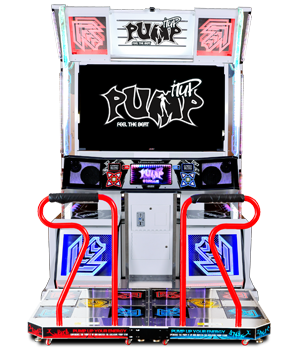
the latest pump it up cab model
it was thanks to that enduring brand recognition/cultural cachet that i found myself quite disappointed when i arrived at the huge new arcade in town on opening day and discovered that they did not have a ddr cab. i had really wanted to finally try ddr out and maybe start playing for exercise, but all they had was a shiny new cabinet of korea’s og ddr ripoff, “pump it up” (piu). the basic concept is the same, except each dance pad has 5 panels, one in each corner and one in the middle, as opposed to ddr’s 4 panels in the cardinal directions. the panel layouts are pretty much exact opposites.
anyways, my prejudice resulted in me stubbornly holding out and waiting a month or two before an actual ddr cab arrived. but when i started playing ddr, i soon found myself alternating between both games before finally having my heart well and truly stolen by piu. now i only play ddr occasionally for a quickie if i spot a free credit left on the cab. in fact, pump it up is pretty much the main video game i play now.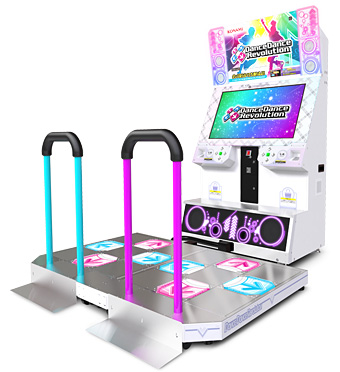
not the newest, but easily the most widespread modern ddr cab model
in this listicle i hope to lay out the definitive reasons for why piu is the discerning dance gamer’s inevitable choice, and perhaps help dispel some of the preconceptions that prevented me from giving piu an honest chance at first. note that i am only arguing that piu is better than ddr currently, as in what you’ll be faced with if you walk through the doors of the arcade right now in the Year of Our Lord 2023. maybe ddr was objectively far better than piu for ten years in the noughties and therefore you can argue that still makes it better overall, i don’t know. i wasn’t there and i don’t particularly care to research that, none of that history is really relevant to somebody going into the arcade today trying to make a decision between the games as they exist now. you can leave those kinds of theoretical arguments to the boomers who were around back then, if they have not yet died of old age. now, let’s get into it.
1. konami (ddr) are actively assholes, andamiro (piu) is merely incompetent but in a sort of charming, lovable-idiot way.
anyone familiar with konami is probably aware that they have a poor reputation of late. i bet there’s quite a few people who only know about konami thanks to all the bad press, because it’s not as if konami is releasing many games lately. once upon a time in a mythical age (the nineties), they developed and published a lot of really great games, but those days are now long gone. what's konami up to now? well, there was this whole scandal a few years back where they cancelled all their new games, fired arguably the world’s most famous auteur video game designer hideo kojima, and announced they were doing all this to focus solely on “mobile games” (almost certainly cheap microtransaction/gacha crap) and of course their cash cow slot machine business. many are probably unaware but konami is actually one of the biggest players in the “gaming” (read: gambling) industry. i went into a completely random indian casino in the middle of nowhere on a lark a couple years back and fully a third of the machines in there were emblazoned with the konami logo.
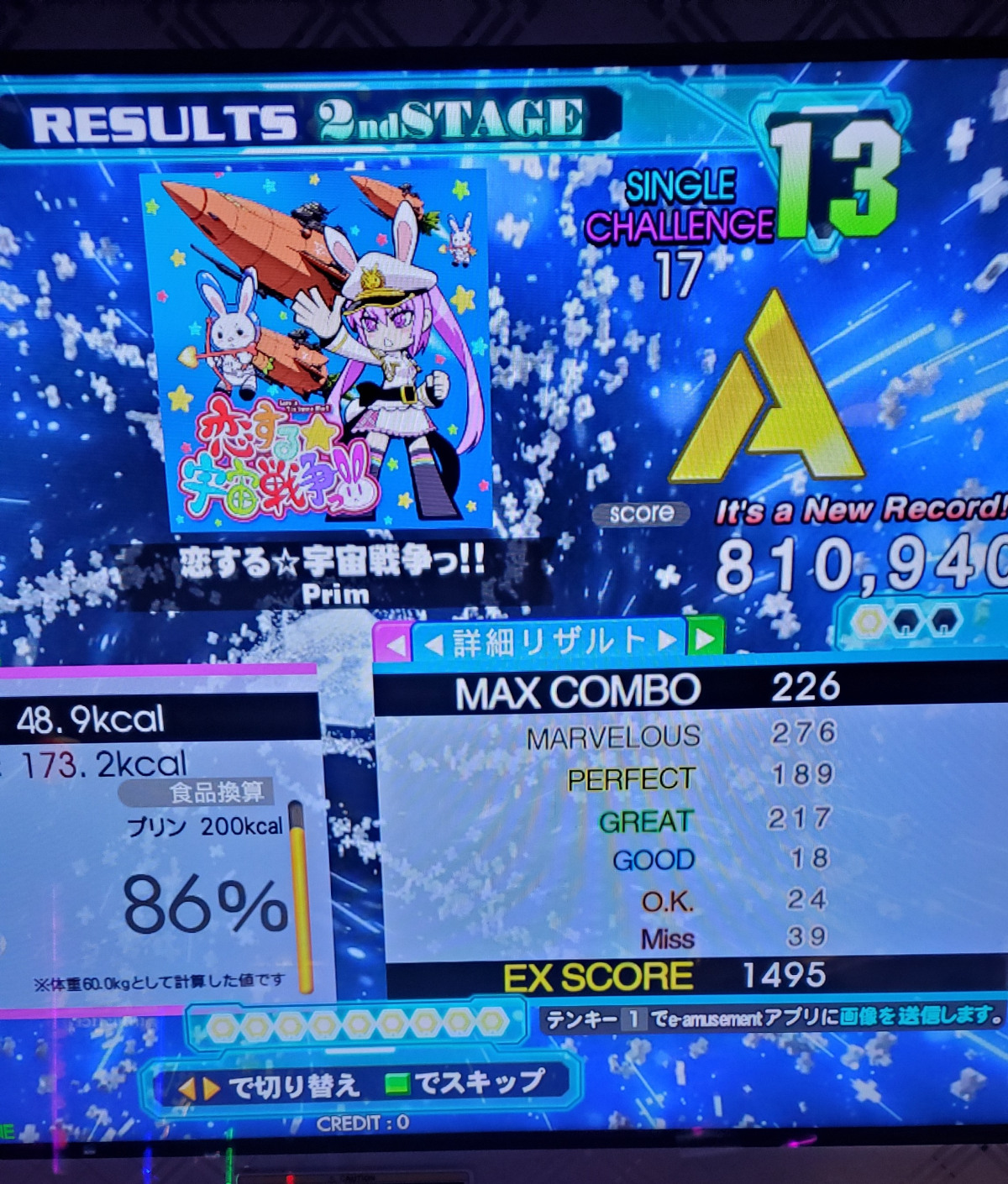
you may wonder if i'm qualified to talk shit about ddr. i hope this is enough, despite the pump player's curse of awful ddr timing. first time i ever played that chart btw.anyways, somehow among all this konami’s arcade game division has lingered, possibly because arcade games are superficially similar to konami’s beloved gambling machines. i think they even tried to make a beatmania casino game once. however, it really feels like they’re phoning it in and trying to squeeze every last drop out of their 20+-year-old arcade franchises with as little investment of money or effort as possible. ddr in particular feels like it’s been left to rot, coasting on its reputation to attract casual players who play one song and then dip. it also seems to be sustained by a dwindling cadre of thirty-year-old ddr boomers who started during and still remember its halcyon days, now grandfathered and stockholmed into the modern version, but who i'm sure will eventually be sucked so dry of motivation and funds by absolute current state of ddr that their desiccated husks will be effortlessly blown off the pads by even the dinky little fans sometimes placed by the cabs for cooling off during intense sessions.
leaving aside konami’s milking and neglect of ddr and its players, there are also its business tactics, which could be described sensitively as “aggressive”, or more accurately, “cutthroat”. at times they’re almost comically gordon gekkoesque, it’s like they’re the living embodiment of one of those business books popular in the eighties when everyone thought japan was going to take over the world financially, titled something along the lines of “Bushido Management: How the Japanese Crush Their Competitors Samurai-Style and How You Can Too”.
for konami’s part, mostly this means a lot of lawsuits and strongarming any potential competitors in the dance game space. i know i said i wouldn’t get too into history, but a lot of the modern dance game landscape has been shaped by konami’s propensity to do everything to cling to their market share except make better gamesfunnily enough sega is now completely destroying konami in the japanese rhythm game space, which they accomplished through, dare i say it, making better games.. way back in the day, they sued early 4-panel dance game competitor “in the groove” into oblivion. before that, they tried to do the same thing to andamiro over pump it up (which originally came out around a year after ddr) by suing them in korea for infringement of the patent in korea for ddr. andamiro survived by outmaneuvering konami and filing a patent for piu in the us, then suing konami in california for infringing the piu patent with ddr. both lawsuits were eventually settled out of court, and to this day piu and ddr are the only (commercial) dance games allowed to have the onscreen arrow-shaped targets at the top of the screen, part of the patents in question. fun fact, this is why the more-recent arcade dance game stepmaniax can only use a vague line at the top of the screen as the target.
more recently, i’ve heard that the konami-andamiro rivalry reignited in the past few years as andamiro made an attempt to push into konami’s sacred home turf of glorious nippon japan with pump it up. konami responded with an ultimatum to the japanese arcades carrying pump it up: ditch pump it up or we’re cutting you off. this was a no-brainer for arcade owners due to konami’s strong position in the arcade game market, although i suppose you could also chalk it up to yet another japonic anti-korean conspiracy as well. in any case, cheap pump it up cabs from japan briefly flooded the international market, to the delight of arcade owners and enthusiasts as far away as swede
i should also put in a word about how konami distributes new ddr cabs in the us these days. once upon a time (i find myself using this expression a lot), you could find ddr cabs in the odd corners of malls, movie theatres, student unions, “family amusement centers”, bowling alleys, and the like. as the cabs grew older, they were eventually hauled off to the junkyard or sold off to languish in a perpetual state of half-repair in the garages of former ddr enthusiastsi have heard unconfirmed rumors that some of them actually did get repaired and are still in active use by a few ddr boomers today. in the place of those old cabs, though, no newer ddr cabs have appeared. why is this? the declining popularity of the game, perhaps, however it’s also because if you’re a small independent arcade or bowling alley owner, konami simply will not sell you a new ddr cab. there are precisely two establishments in the us, both national chains, where you can find the latest ddr cabs: dave and buster’s and round 1. i have heard that this is because konami doesn’t want to bother fulfilling anything other than bulk orders, which only those two national chains are equipped to make.
now andamiro isn’t entirely flawless either, although konami is such a turd that andamiro comes out looking quite good even doing the bare minimum. for example, do you want to buy a new pump it up cab? easy, just find one of andamiro’s many distributors in the us, fork over 16 large, and you’re good to go, even if you’re just ordering one for your home’s garage/basement/gym. this is part of the reason why you’re starting to see pump it up cabs appearing in some of those places where ddr cabs used to be staples. do you want all of the online services as well? just run an ethernet cable to the back of the cab and you’re done, no need to pay extortionate eamusement network fees to konami like round 1 and friends.
you do get what you pay for, though, and on at least one occasion andamiro managed to lose almost all of the piu data on the servers. i like to imagine some intern carrying coffee in the office tripped over the main piu database servers, then the coffee went flying and fried all of the backups as well. perhaps i am being a bit generous in imagining they had backups. in compensation, andamiro made every unlockable chart cost 1 point and then gave everyone something like 200,000 points so they could unlock them all, which meant a lot of clicking and waiting on the website if you did not use a javascript script to automate it. more endearing jankiness, i can only assume that they had to do this roundabout method because the system had no way to manually unlock songs, but what they did have was an easy way of handing out points to everyone and modifying the cost of charts online.
and of course, pump it up still feels like an actively supported game. there are updates or events every few months, with new songs original and otherwise, the newest stepcharts feel fresh, innovative, and better than ever. the latest cab model is also still quite new and modern. admittedly the pace of updates has slowed considerably lately, but they have already supported the latest version with a lot more updates than they originally intended to. additionally, the slower pace is probably because they are gearing up for the next version, to be announced this year. also, unlike konami neglecting ddr to focus on slot machines, i think they are quite busy over at andamiro with their new rhythm game chrono circle, in addition to pursuing weird side projects like pump it up in roblox (yes, that happened).
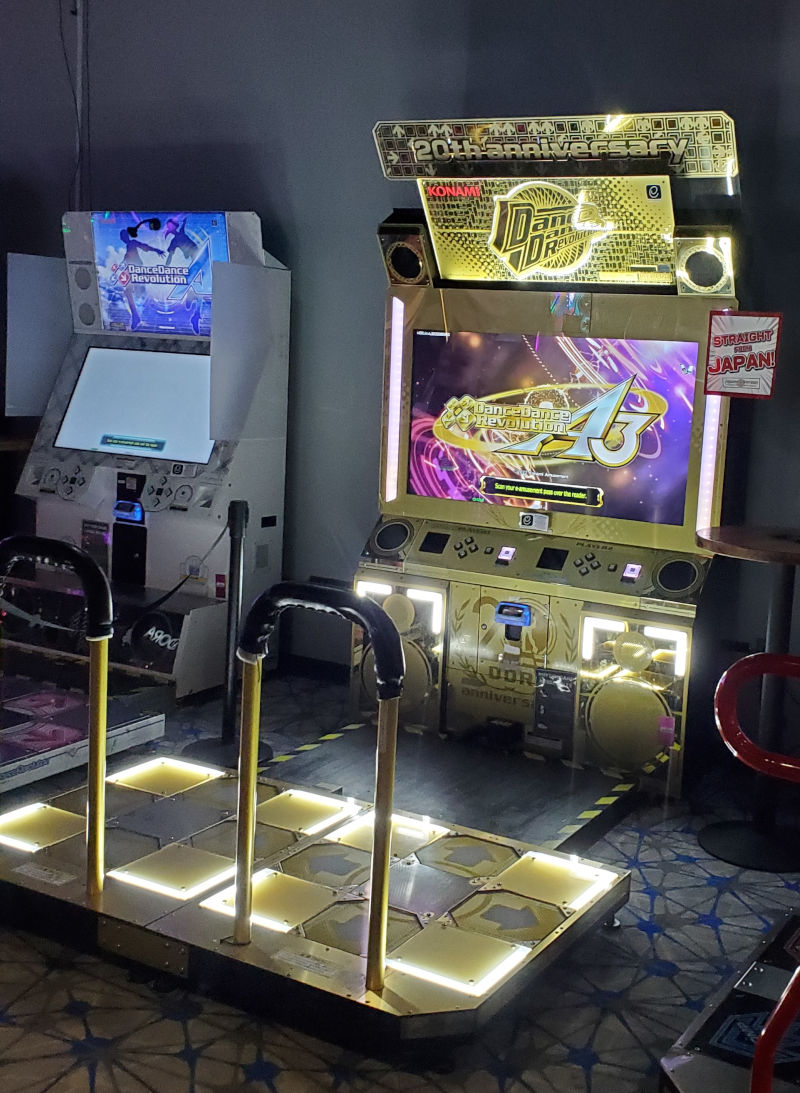
rare photograph of a mythical gold cab in the us running the latest version of ddr. developed from a film canister pried out of the presumed photographer's mummified fingerskonami, to be fair, has released a new cab somewhat recently and a new version last year, but the execution leaves a lot to be desired. the new “gold cabs” are basically just reskinned dancerush cabs, and they’re still quite rare stateside. for some reason the latest version of the game is also only available on said gold cabs in the us, even though in asia it’s already been available on the older, more widespread white cabs for a while. so now you’ve got dedicated players making long pilgrimages to wait in line for a go at a gold cab with the latest version. also, annoyingly if you migrate your account to the new version by using it on a gold cab, you won’t be able to use it on the older white cabs anymore. all of it is really quite perplexing.
on top of all of this, there really isn’t that much new stuff in the new version. they finally made it possible to switch between doubles and singles on the same credit, a feature that has been available for years in pump. there's a handful of new originals and some low-hanging fruit like touhou licenses and crossover songs from other konami rhythm games. over a third of the new songs are also locked behind paywalls and other nonsense. overall it seems like just an excuse to milk some more money out of dedicated players by wiping regional high scores like they do with every major update and forcing them to come in and play a ton to regain them.
i hope you've gotten comfortable because that there was 1600 words, and i've only gotten through one of ten reasons.
2. the pump it up pad layout is clearly superior
in my opinion, the 5-panel layout of the pump pad is much better than the ddr 4-panel layout. it’s difficult to describe, but something about ddr’s four panels in the cardinal directions just feels stiff and awkward, and from talking with others i know i’m not the only one who feels this way. i think the rigid 90 degree angles between the panels contribute, along with the fact that there's not much space between them, which for example makes it possible for “foot wiggler” 4-panel stamina players to just stand in the center and move their feet as little as humanly possible (greased up with all sorts of weird thin shoes or layers of socks, strange powders, ultra-sensitive pad modifications, and of course actual grease) so they can hit something like ten arrows a second for twenty straight minutes or whatever. 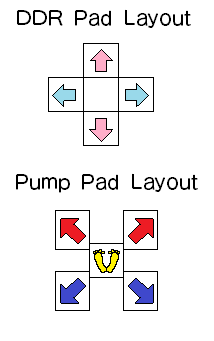
i spent too long making this handy visual aid in ms paint
pump's 5-panel layout, on the other hand, not only feels like it flows better (could also be because flow is important in pump charting, more on this later) but also has more charting possibilities thanks to the extra panel. pump's pad layout subtly contains an additional step option as well: brackets. upon close inspection, you'll notice that pump's corner panels are actually all rectangles, extended towards the middle and thus overlapping slightly with the middle panel. this means that with some aim, you can reliably hit both the middle panel and one of the four corner panels with the same foot, which is known as a bracket. it's an advanced technique because the target area is a lot smaller than a full panel, but it's extremely satisfying to pull off and adds a lot of depth to the game once brackets start to show up in more difficult charts. it's effectively like having four extra panels to work with.
while it's theoretically possible to hit two panels with one foot in ddr, in practice the pad design makes it too difficult to pull of consistently. the panels are all perfect squares and do not overlap at all so the area you have to aim for is even smaller than in pump. ddr panels also tend to be more sunken in and are secured in the corners with these big screws and triangular metal brackets which makes hitting panels in the corner uncomfortable as well. older pump panels used to be built the same way, but i suppose as brackets became increasingly important in charting, they got rid of them in new pad models and now pump panels are ideally flush with the rest of the pad.
in any case, the outcome is that brackets are pretty much never explicitly charted (e.g. three arrows at once) in ddr. in fact i don't think i've ever encountered one in a ddr chart. i have seen some in itg, however, which has the same 4 panel layout. usually itg pads have been extensively modded to remove the metal corner brackets, raise the panel, and increase sensitivity, all of which make it easier to hit brackets. even so, three arrows at the same time are rarely done as brackets in itg. instead, they're known as "hands" in itg because for the most part you're supposed to do them by bending down and hitting the third (or fourth!) arrow with your hands. believe it or not but somehow they make this work in itg charting. i once played this somewhat difficult caramelldansen itg chart which had a lot of sections where you're supposed to hold two arrows while hitting the other two in an alternating patterni believe it was this chart. the pattern i'm referring to appears around 1:53 and in a couple other places. i tried to play it as brackets which is theoretically possible, but it was a struggle. then the guy after me hopped up, said "this is how it's done", and did those parts flawlessly by planting his feet on both holds, bending over, and slapping the other two arrows with his hands as needed. i was quite impressed although i never got the chance to try it myself.
then, there's doubles. there is a reason why you never see anyone playing ddr doubles, whereas every serious pump player is deep into pump doubles. in fact, pump singles difficulty maxes out at 26 whereas doubles continues up to 28. i myself regret not taking the advice of pretty much every decent pump player i met and starting doubles sooner. frankly doubles should probably be a reason on its own, but oh well, we'll see where this goes.
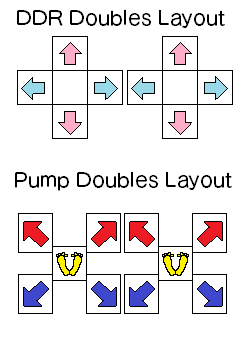 doubles is where the pump pad layout truly shines. if you've tried both it shouldn't even be a question of which is better, but i'll lay out (get it?) some reasons anyway. i think the main issue with the ddr doubles layout is that the middle ends up feeling like kind of a dead zone, since you have just two adjacent panels there with a lot of empty space. this also means that there are very few options for charting transitions between the left and the right sides, especially ones that flow well. pump's layout, on the other hand, has four panels in the middle, which alone leds itself to pretty much as many charting possibilities as ddr singles. on top of that, there's no other dance game with 4 panels arranged like that, so most of the middle patterns are unique to pump. it's practically a whole game within a game, and there are quite a few charts with extensive middle sections, including a few doubles charts that only use the middle.
doubles is where the pump pad layout truly shines. if you've tried both it shouldn't even be a question of which is better, but i'll lay out (get it?) some reasons anyway. i think the main issue with the ddr doubles layout is that the middle ends up feeling like kind of a dead zone, since you have just two adjacent panels there with a lot of empty space. this also means that there are very few options for charting transitions between the left and the right sides, especially ones that flow well. pump's layout, on the other hand, has four panels in the middle, which alone leds itself to pretty much as many charting possibilities as ddr singles. on top of that, there's no other dance game with 4 panels arranged like that, so most of the middle patterns are unique to pump. it's practically a whole game within a game, and there are quite a few charts with extensive middle sections, including a few doubles charts that only use the middle.
the adjacency of the middle panels also results in two more bracket possibilities: hitting both the top panels, or both the bottom panels at once. this means in pump doubles, you've got the ten normal panels (already more inputs than iidx or even pop'n) plus four brackets on each side and then the two middle brackets for a total of 20 different possible individual steps. that plus all the combinations (splits, jumps, triplets, quads) means the potential patterns are practically endless, even when you restrict yourself only to ones that flow well. oh, and of course there's also a few charts where you have to hit some panels with your hands too.